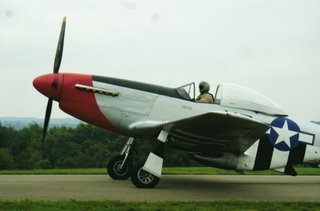Nibble, Nibble
Today I logged 2.2hrs with my instructor and nibbled away at those requirements. I woke up and headed straight to the airport for my final attempt to complete the FAA-mandated requirements for a private pilot. Our plan was to head to Mansfield, OH (MFD) for 2 additional solo landings at a towered airport, and to log an additional 1.3 hrs of simulated instrument.
The weather was beautiful and the air was smooth as we took off from Coshocton. However, by the time we had reached Mohican State park, the wind had picked up considerably, and we were assaulted with the eddies and currents of turbulent air flowing over and around the hills up there. I made the decision to fly up at 2500ft, simply because it's easier to look at things on the ground from 1/4mile AGL instead of 1/2 mile AGL. It was a rather bumpy decision. Not to mention a slow one. At an indicated airspeed of 105-110mph, we were only making 75kts ground speed. By my calcs, that's about a 20kt headwind enroute.
Got to Mansfield, let my instructor out at the Flying Turtle Cafe, and proceeded to make two full stop landings to finish out my requirement. There was some traffic this morning...a C-130 Hercules, caravan, a couple of Skylanes, and two Cherokees in and around mansfield as I was flying the pattern. Busy, but really fun to actually NEED the controller in the tower and to have them help you out with traffic locations and the like. It was good experience.
After Walt downed his breakfast, we packed up and headed back to Coshocton. On the way, I put the hood on and picked up another 0.7hrs of simulated instrument time. The wind had picked up a little more, and it was really tough to maintain altitude due to all the up- and down-drafts. This was my first time flying a course heading with the hood on...you know ACTUALLY flying to a destination, so that really helped me to see the usefulness of the GPS and CDI when flying in IMC. I managed to end up over I40, where we practiced a simulated engine-out landing (full idle from 3000ft). You really have a lot of time to deal with an engine failure when 2000ft AGL, as I learned. I also learned that a you want to head INTO the wind when doing this for real. We had an 80-degree 10kt cross-wind on landing, and coupled with the non-standard approach, it was pretty challenging to get on the ground. I'm going to say that it was almost as nice as this wheel landing that P-51 "Red Nose" did at the Wings Over Coshocton Airshow earlier this year.
 Due to the gusting winds, I was not able to log all the simluated instrument time that I needed, but since the weather tomorrow is supposed to be good, I'm scheduled for another morning in the air.
Due to the gusting winds, I was not able to log all the simluated instrument time that I needed, but since the weather tomorrow is supposed to be good, I'm scheduled for another morning in the air.
The weather was beautiful and the air was smooth as we took off from Coshocton. However, by the time we had reached Mohican State park, the wind had picked up considerably, and we were assaulted with the eddies and currents of turbulent air flowing over and around the hills up there. I made the decision to fly up at 2500ft, simply because it's easier to look at things on the ground from 1/4mile AGL instead of 1/2 mile AGL. It was a rather bumpy decision. Not to mention a slow one. At an indicated airspeed of 105-110mph, we were only making 75kts ground speed. By my calcs, that's about a 20kt headwind enroute.
Got to Mansfield, let my instructor out at the Flying Turtle Cafe, and proceeded to make two full stop landings to finish out my requirement. There was some traffic this morning...a C-130 Hercules, caravan, a couple of Skylanes, and two Cherokees in and around mansfield as I was flying the pattern. Busy, but really fun to actually NEED the controller in the tower and to have them help you out with traffic locations and the like. It was good experience.
After Walt downed his breakfast, we packed up and headed back to Coshocton. On the way, I put the hood on and picked up another 0.7hrs of simulated instrument time. The wind had picked up a little more, and it was really tough to maintain altitude due to all the up- and down-drafts. This was my first time flying a course heading with the hood on...you know ACTUALLY flying to a destination, so that really helped me to see the usefulness of the GPS and CDI when flying in IMC. I managed to end up over I40, where we practiced a simulated engine-out landing (full idle from 3000ft). You really have a lot of time to deal with an engine failure when 2000ft AGL, as I learned. I also learned that a you want to head INTO the wind when doing this for real. We had an 80-degree 10kt cross-wind on landing, and coupled with the non-standard approach, it was pretty challenging to get on the ground. I'm going to say that it was almost as nice as this wheel landing that P-51 "Red Nose" did at the Wings Over Coshocton Airshow earlier this year.

 Due to the gusting winds, I was not able to log all the simluated instrument time that I needed, but since the weather tomorrow is supposed to be good, I'm scheduled for another morning in the air.
Due to the gusting winds, I was not able to log all the simluated instrument time that I needed, but since the weather tomorrow is supposed to be good, I'm scheduled for another morning in the air.

0 Comments:
Post a Comment
<< Home